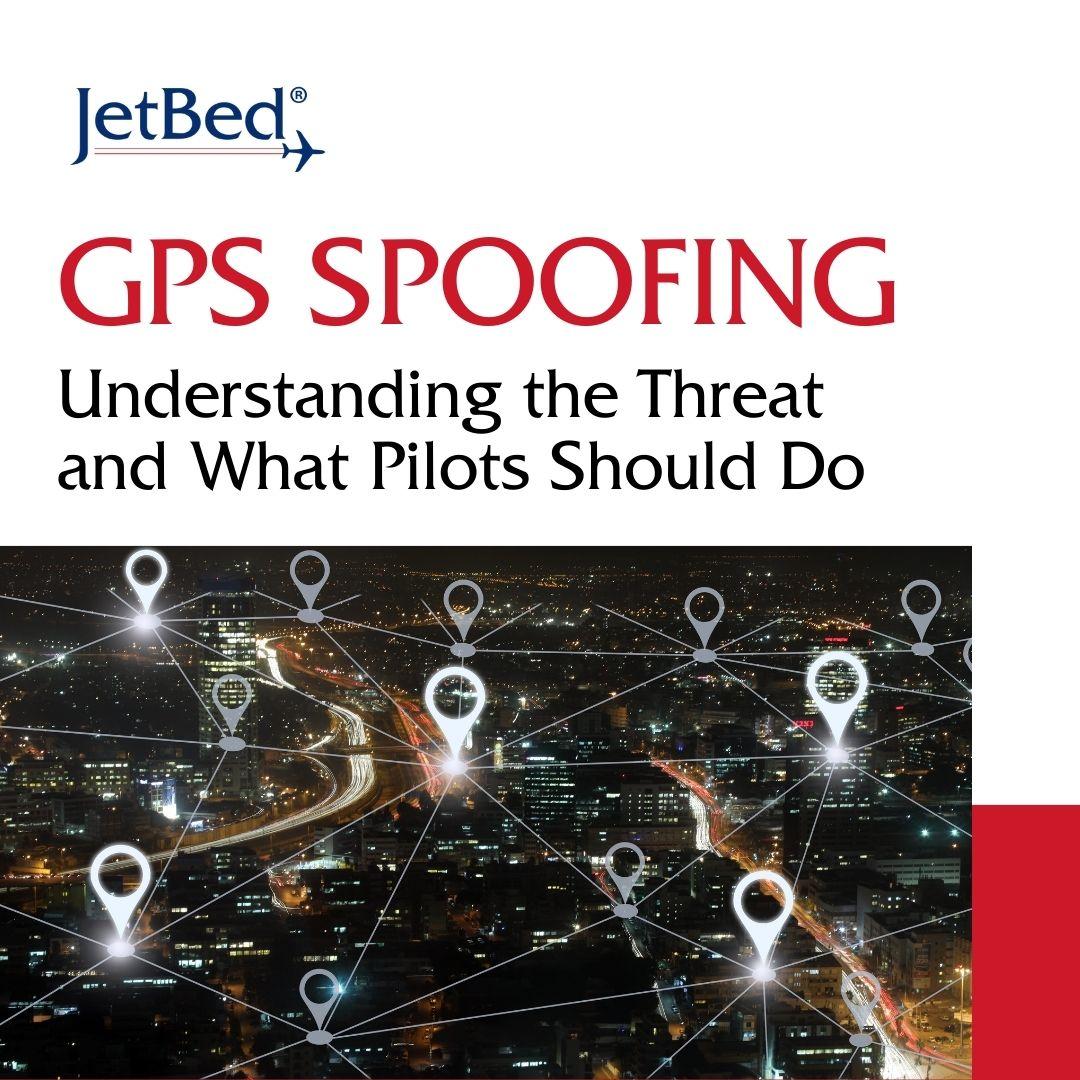When operating an aircraft, pilots and crew must be aware of the various threats that can arise during flight. It is important for aviators to familiarize themselves with potential risks so they can handle any issues appropriately if the need arises. One increasingly common threat is GPS spoofing. As aircraft become more reliant on GPS for navigation, understanding how to identify and mitigate this threat is crucial.
In this post, we will explore the danger of GPS spoofing. We will discuss what it is, how it can impact aviation safety if undetected, and what crews can do to recognize when it occurs. By learning about GPS spoofing tactics, identifying spoofing through detection methods, and being prepared to respond with countermeasures, pilots and operators can properly manage this navigational threat.
But before you dive in, be sure to check out our range of JetBeds. Made in the USA, Jetbeds are the most comfortable way to fly!

What is GPS Spoofing?
GPS spoofing has posed risks to aviation for years, but recent advancements now make it an especially serious concern. In essence, GPS spoofing is the deliberate transmission of fake gps signals with the goal of overriding the real location data from satellites. Instead of receiving real position information, timing and velocity from GPS satellites, a spoofed aircraft is fed fabricated GPS data that misrepresents its actual whereabouts.
While previously limited in scope and impact, contemporary spoofing methods cause substantial unease. Utilizing sophisticated signal processing techniques, adversaries can now expertly mimic legitimate GPS signals in ways that evade detection. This evolved deception threatens flight safety, as aircraft may fly off course for prolonged periods before crews recognize the hack.
Left unaddressed, spoofing endangers lives by risking controlled flight into terrain or obstructed airspace. The aviation community must treat this navigational attack seriously due to its potential for stealthily inducing dangerous spatial disorientation. Confronting spoofing vulnerability proactively through education, technology upgrades and best practices is therefore imperative.
How GPS Spoofing Works
By understanding the mechanics of GPS spoofing, its impact becomes clearer. The process begins with spoofing equipment generating counterfeit GPS signals that contain bogus pseudo-ranges, time data and other location parameters. Using advanced signal simulators and high-gain antennas, threat actors then broadcast these fabricated signals or “spoofing signals” with strength levels that override real data broadcasts from GPS satellites.
The spoofed signals are algorithmically designed to seem authentic as they track targets and mimic normal satellite mobility. When received by an aircraft’s GPS receiver, the artificial information is indistinguishable from proper location updates. Not realizing the input is fake, flight navigation systems accept the fake GPS location as genuine and truthfully reflect them on displays. Spoofing equipment generates fake GPS signals much like how a location spoofer app on an Android phone generates mock locations.
As a result, the aircraft is unknowingly misguided. Charts, mapping functions and navigational instruments all report an illusory flight path rather than factual positioning. Even the aircraft’s internal clock may be fooled into reflecting the hacker’s time rather than Zulu.
This fabricated reality has led aircraft astray, prompting them to stray from routing, approach unstable airspace or exceed altitude limits without the crew’s awareness. Such consequences make GPS spoofing a menace that cannot be taken lightly.
Difference Between GPS Spoofing and Jamming
While both spoofing and jamming disrupt normal GPS function, there are important distinctions between the two threats. Jamming simply transmits noise or signals to obstruct genuine GPS transmissions from being received. It prevents acquisition of any positional data until the jamming ceases. Though disruptive, this type of attack is also easier to identify since it causes the loss of all GPS information.
GPS spoofing is a stealthier form of attack. Rather than disconnecting the GPS signal, spoofing inserts fabricated location data to supplant real coordinates without the user recognizing deception has occurred. This makes spoofing harder for flight crews to spot, as normal GPS operation appears unaffected. However, spoofing is actually manipulating the aircraft’s path remotely without the crew’s knowledge.
As a result, spoofing poses heightened safety risks compared to jamming. It can guide aircraft significantly off course before detection, possibly putting the flight in unintended airspace or unstable flight environments. Jamming at least denies data upfront, while spoofing feasibly misdirects navigation for an extended period.
This potential for long-term covert GPS manipulation makes spoofing a particularly serious concern for aviation safety and security. Vigilance around this emerging threat is thus strongly advised.

How To Detect GPS Spoofing
Discrepancies between GPS and other navigation sources.
Comparing the GPS reported position to navigational information from other sources like VOR, DME can help crews detect inconsistencies that may indicate spoofing. Disagreements between GPS coordinates and data from additional avionics systems suggest the potential for manipulated GPS signals.
Anomalies in GPS measurements.
Spoofing may cause abnormal GPS measurements like improbable altitude, ground speed, or timestamps that conflict with reality. Parameters not aligning with the actual flight environment could uncover a false GPS being injected by a location spoofer.
GPS position freezes or drifts slowly.
A properly functioning GPS should show dynamic updates, whereas spoofing may cause the displayed location to freeze or move in unrealistic pacing. Erratic GPS behavior needs scrutiny.
Multiple GPS receivers disagree.
If an aircraft has multiple receivers, comparing the position from each helps identify if only one is being spoofed. Discrepancies between receivers implicate a probable local spoofing attempt.
Warning messages from advanced avionics.
Modern avionic suites may detect abnormal GPS functionality and discrepancies. Alerts about failures, outages or questionable GPS vs other data mismatches warn of potential spoofing incidents.
These detection methods give flight crews analytical tools to recognize spoofing and differentiate actual GPS signals from manipulated data. Corroborating GPS findings aids identification and response to this navigational incursion.

Aircraft GPS Spoofing Countermeasures
Crew Procedures
Closely monitor instruments for anomalies and promptly alert ATC of any dubious GPS behavior. Preparedness to navigate without GPS aids swift response if needed. Consider preemptively rerouting from known risk areas when possible. Heightened situational awareness is a simple yet potent tool.
Equipment
Dual GPS receivers installed let comparison for local inconsistencies, aiding detection. An antenna diversity system provides redundant valid signals, hardening reception. Adding other avionic sensors for GPS cross-checking and backup strengthens resistance. Upgraded anti-spoofing antennas and receivers make reconnaissance tougher for adversaries.
Augmentation systems
Precisely calibrating GPS coordinates with precision approaches, SBAS corrects errors, and RAIM autonomously validates accuracy. This both deters spoofing and immediately flags invalid deviations.
Monitoring enhancements
Advanced systems continuously assess data coherence, quickly pinpoint conflicts between authentic location-based data and mock locations. Algorithms rapidly flag anomalies, complementing crew insights. Integrating multiple tools multiplies opportunities to spot abnormalities.
When paired with educated operating practices, these countermeasures form layered protections. Their effectiveness discourages spoofing attempts and empowers rapid response if needed, together safeguarding navigation.
FAA GPS Spoofing Advice
The FAA provides guidance for pilots encountering potential GPS spoofing in flight. The agency recommends heightened monitoring of all avionics for irregularities upon any initial GPS anomalies. Crews are advised to promptly notify air traffic control about issues to facilitate support and non-GPS navigation if needed.
The FAA also instructs pilots to confirm GPS malfunctions by cross-checking positional data with alternative sensors like VOR and DME when available. If inconsistencies between GPS and other systems arise, pilots should consider the GPS signal compromised until landing. Transitioning to full non-GPS flight profiles guided solely by alternate means is an option in more serious spoofing scenarios according to FAA procedures.
Overall, the administration’s advice underscores the importance of open communication and multi-system corroboration to swiftly discern and contain spoofing attacks. Pilots are empowered to decide the safest mitigation based on their aircraft’s capabilities and each incident’s unique needs. With layered defenses and prudent operating skills, aviation can better defend itself from the evolving risks posed by GPS interference.
Prioritizing navigational integrity above all else is key to resiliently transporting passengers into the future of global air travel.
With the ever-present risks that GPS interference poses to aviation, educating pilots and crews on effective countermeasures is paramount. By comprehending spoofing tactics, identifying anomalies, and implementing layered technological and procedural defenses, the aviation community strengthens its resilience against compromised navigation.
While threats continue advancing in scope and subtlety, knowledgeable operators guided by regulatory best practices can uphold safety. With open communication of issues and cross-validation of systems, aviation maintains the capacity to navigate hazards including both physical and digital navigation disruptions.
Now that you know everything about spoofing, remember to also always ensure your jets are equipped with JetBed. Our innovative product transforms your jet seats into luxurious, comfortable beds for optimal in-air sleeping. They’re easy to use, lightweight, and fits almost all aircraft. Whether you’re a pilot or a passenger, you don’t want to take off without one. So, don’t settle for less when it comes to chartered flights; keep JetBed on your must-have list!
We hope this discussion on GPS spoofing helps to increase your knowledge bank on all things aviation. You can always refer to our blog for other similar informative posts such as Safety Pilot Requirements and Safety Management Systems in Aviation!

